Finally, after seven years and after coronavirus, people from the anthroposophical movement came together again at the Goetheanum at Michaelmas. The exchange between the centre and the periphery flourished for three days. The Goetheanum World Conference was a highlight of the year.
It was the best weather: golden light and the late summer warmth which radiates not only from the cosmos but also from the earth. After the opening fanfare, I met a friend I hadn’t seen at the Goetheanum for a long time. She laughed and said, with a wink, that she was here for the “party” and to meet her “karma people”. Yes, that is indeed what it felt like: a lively gathering of 1,000 friends—like-minded people, people of all stripes, from all over the world. They had responded to the call of the Goetheanum Leadership, maybe carrying a bit of doubt and scepticism in their luggage, in order to consider the question of how the anthroposophical movement and its work in the world could, should, must, and wanted to be reshaped after 100 years.
It was impressive to see how many different ways this question can be set in motion, when so many distinct people and areas of life feel, think, and talk about it. The preparatory team composed twelve different forums with questions based on the 400 letters that came back to the centre after being requested from the periphery: Where are our contributions to the future of the earth? How do we create peace? How are the health of people and the earth connected? How do we establish associative work as a cultural technique? What perspectives on transhumanism arise from anthroposophy? How can anthroposophy be strengthened in the public arena? And how do we communicate properly to the outside world? How do we create leadership and new perspectives with the tool of anthroposophy? How do I move from meditative self-discovery to cooperation with the world? How will the search for the I contribute to the current debates on interculturality, gender, karma, and reincarnation? What can art contribute to the current challenges? And how do we transform the primacy of modern science?
Peter Selg characterised the Anthroposophical Society as the body of hope of a we-community. Maaianne Knuth saw anthroposophy as a healing movement. Volkert Engelsman called on the “coalition of the willing” to leave the safety of home and have the courage to be vulnerable as anthroposophists. Marjatta Van Boeschoten saw the Society and the movement as a kind of cultural womb for each of us. We shouldn’t keep anything to ourselves; we should open up completely, said Gerald Häfner. And Ueli Hurter asked us to speak in such a way that it is clear that there will be no one who can do anything for us; only we ourselves can do it. Many people talked about their experiences, sharing their thoughts, views, and wishes. Our shared anthroposophical existence affirmed our humanity and thus, our being in the world in a loving, warm, and open way. That, at least, lived in the encounters.
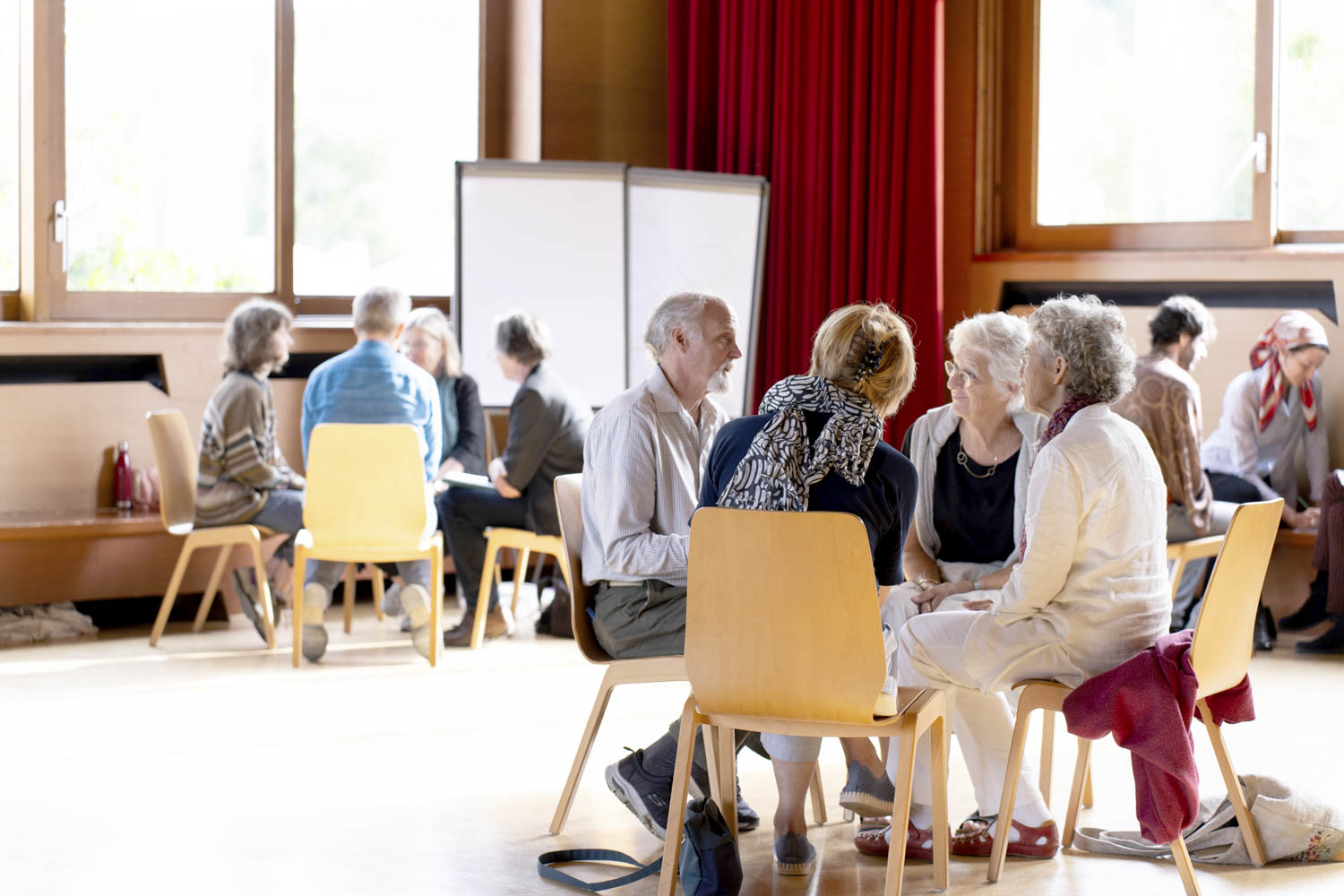
Craig Tilsley (South Africa)
This World Conference was my first visit to the Goetheanum. It was amazing. The Goetheanum itself was mind-blowing. The enormity, the beauty, the sombreness, the sobriety—all are very special. The Wooden Sculpture was particularly striking. There was a clear desire from those running the Conference to be as inclusive as possible. This certainly calmed my own concern about not being able to speak German! The place was alive, from before the start of the conference to after the end, with the only quiet being in the sleeping hours. Those evening shows were incredible! And then, of course, the wonderful people at the conference—different cultures, different languages, chance meetings, the insights—what a delectable pot. Thank you, members of the GAS [General Anthroposophical Society.] And thank you to those of the Goetheanum.
Tanya Coburn (Australia)
How do I fit into the anthroposophical movement? What needs reshaping in the movement? What needs reshaping in me? These were the questions I carried as I journeyed 10,000 miles, curious that I felt compelled to attend. I was surprised and relieved by the uncertain, stammering trumpet call at the opening, urging us to wake up. I marvelled as the powerful artwork with its message of challenge and chaos was lowered into view. And I cried. How do we meet polarisation, alienation, and destruction without falling into sentimentality or resistance? Where is the balance? In the workshop on “The Courage to Be Vulnerable”, I felt most strongly met. When we were encouraged to share an experience of shame or not fitting in with two companions in an exercise, I was deeply heard and truly understood. I return home with a clearer perspective on my own challenges and my own path, confirmed in my grounding in a movement clearly willing to meet its new century with courage, with creativity and transformation.
The Courage to Remain a Fragment
Vulnerability seemed to be a thread running through these days. “We are a learning movement,” someone confessed. There is room for mistakes and, above all, the space to show oneself in one’s wounds and vulnerability. It means knowing that nobody has the absolute answer, that there can be no such thing. Our ideals are “ensouled ideas that appeal to the will”, as Peter Selg described it. The field of action is always the place where we can fail. And yes, there is something Michaelic about it when the will of the other lives in my heart. But that needs to be practised. Art can help us in this. It makes it possible to dare the imperfect. Creativity is not a product but a process that begins in each individual.
The workshop “Vulnerability As a Resource”, organised by a World Goetheanum Association research group that has been working primarily in and with companies for four years, was more explicit about this. What riches are revealed when we understand vulnerability as a core competence? A vulnerable encounter is always a real encounter. Vulnerability, not hurt, as an ability, is the bridge to being able to perceive the suffering of the other. Interestingly, the dreaded moments when we painfully feel another person’s defensiveness, or perhaps don’t want to be “touched” so closely ourselves, don’t come to pass. Our human life miraculously prevents this; I can trust that nothing will happen to you or me if we know what we are doing. A consciousness takes place—it is life, not a construct.
Christine Gruwez described “anthroposophical consciousness” as a key that can open various doors through which we can see things differently. And this key makes it possible to decode the world in all its diversity. The second verse and gesture of the Foundation Stone meditation, parts of which were performed by the Goetheanum Eurythmy Ensemble in the morning, begins in the heart region and spreads out into the horizon. “The heart region awakens. A certain warmth arises, a centre from which the substance of the heart’s warmth can flow out. Embrace is the beginning of what periphery means. And humanity emerges from these surroundings.” This is how Christine Gruwez opened her contribution. When this gesture arises in a person from the centre, anthroposophy is renewed and “reshaped as a world movement in constant becoming of human beings and humanity. Anthroposophy as a world movement cannot be something acquired, because if it were, there would no longer be a movement.”
In three motifs, Gruwez outlined encouraging thoughts for a future relationship between key and keyword. It takes the courage to remain a fragment. If we want to shape what is coming into being, it cannot be about a final form. We are dealing with temporal forms. They take into account what is timely—what is appropriate and suitable for a given time. In every temporal form, a space must remain free for the possibility of taking a next step. A single form can never contain the entire potential. But the temporal form can bear witness to the potential, to its striving for wholeness.
So, the courage to be vulnerable is needed. It is rooted in the human being itself. “Is there a more vulnerable gesture than when we spread our arms from the heart to embrace the surroundings?” asked Gruwez. But that doesn’t mean being unprotected. Human beings will carry into a world devoid of God, what is within them, Rudolf Steiner describes in his leading thoughts about the future of humanity and the activity of Michael. What is in them—their being as it has become in this age? Gruwez sees it as a moment of reshaping when, despite the public attacks, we realise that there is someone who walks alongside us through this world devoid of God in the same vulnerability. That means we are not alone. Bearing it together creates new temporal forms.
And then we need the courage to stay awake, she concluded her short address. The circumstances of the times have called us to awaken, but can our hearts remain awake even after we have left the conference? The Foundation Stone meditation was laid in this wakeful heart, Gruwez said. It is the place where hearts begin to have thoughts. This gives rise to cosmic creative deeds.
Grace Zozobrado-Hahn (Philippines)
The conference was amazing for me in several ways. Although there was a clear form (thanks to the work of many people), I got the feeling that process was very much at the center of how the conference evolved. There were many young participants, and it was a joy and a source of hope that the future cannot be so disastrous when many young ones are passionately engaged in various ways to spread the good in the world. I was able to reconnect with many old friends and also had a number of beautiful encounters with new faces. The weather was lovely, and this lent a more vibrant atmosphere, as many had their meals and conversations outside. It was very palpable how the speakers spoke from the heart and how passionate they were about their advocacies. The workshops I participated in worked on very relevant topics. The food was good (although as far as this item is concerned, I posed the question to myself: “Would it not have also been alright if there had been less food, in the light of the financial challenges that the Goetheanum is facing?”). The evening performances were truly great. I left the conference renewed in the knowledge that anthroposophy is alive and that, in the hands of the younger generation, it will continue to engage in the issues of the times and help fructify humanity’s evolution.
Theresia Alt (Germany)
The last time I was at the Goetheanum was over 20 years ago, and, at the time, it was painful to experience all the moral prohibitions and commandments that made any collaborative work narrow and lifeless. Now, a new spirit was really present. The speakers truly embodied a lived appreciation, presence of mind, and inclusion. That also meant that almost everything was spoken in English and many nations were included! Presence of mind was particularly evident in the “The Courage to Be Vulnerable” workshop, where the participants shared their experiences and emotions of the moment and engaged in exercises of encountering others. They laughed and cried together without sentimentally dwelling on pain and suffering. The constant translation from the original language into German or English allowed for a slowing down, a special attentive listening. This deepened the encounters—a nucleus for future collaboration!
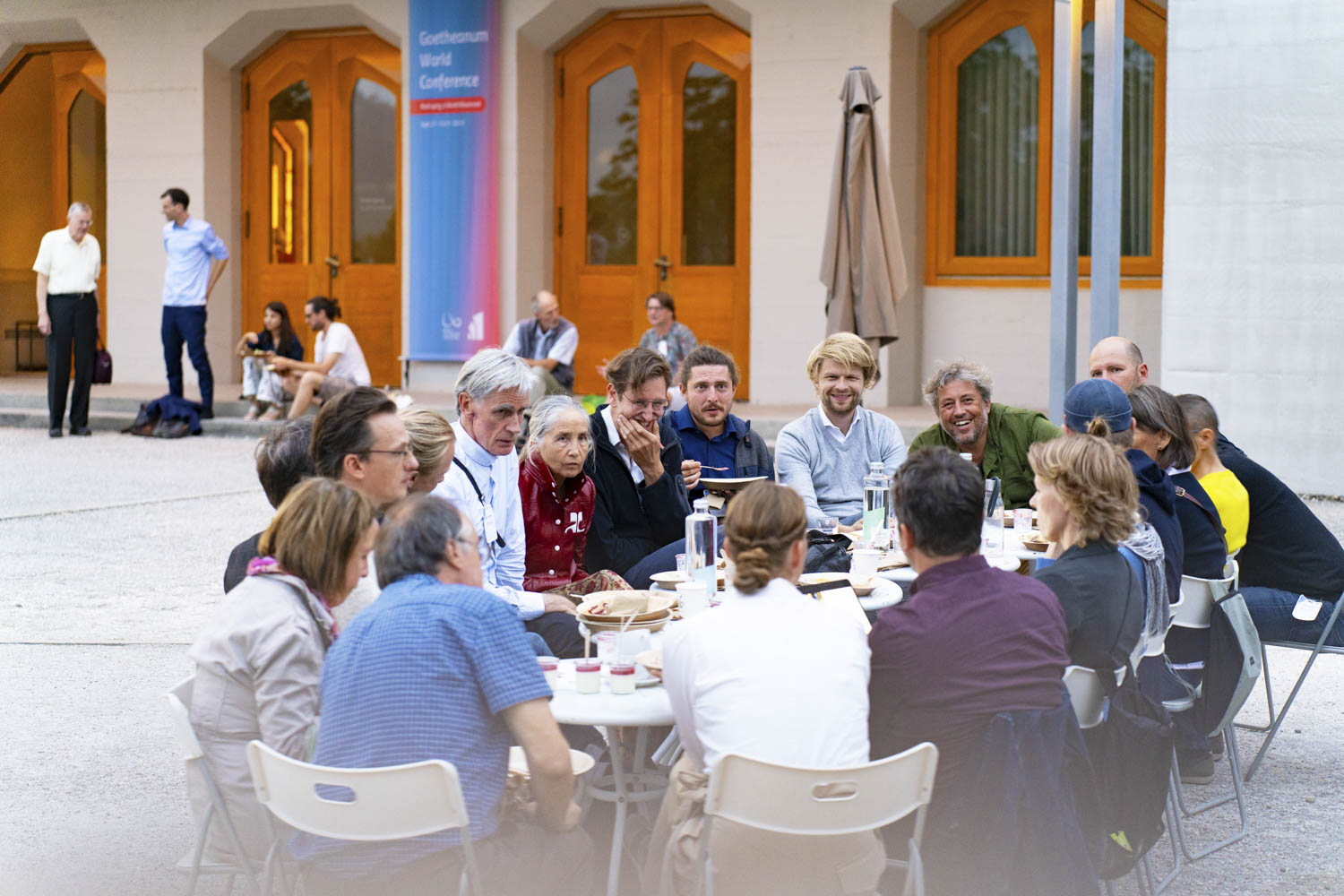
Between Society and Movement
There are 35 national anthroposophical societies worldwide, with approximately 41,000 members. It is estimated that around one million people are involved with the anthroposophical movement. This number is growing every year. There are more and more farms in the world that want to work biodynamically and kindergartens that are oriented towards Waldorf education. The Anthroposophical Society, however, is shrinking. Around 1,000 members join every year, but more are leaving. Who is responsible for “Anthroposophia”? One might think that it was brought into the world by Rudolf Steiner and is now freely accessible to every human being out of their own responsibility. A young woman from India asked why, if a society begins with love and comes into life, the movement should still be called “anthroposophical”. Someone else told me that she only became a member of the Anthroposophical Society many years ago because it protects the Goetheanum building from dilapidation.
The centre is in this field of tension and, based on its heritage and 100 years of work in the world, poses the question for the future: How and where will the movement be able to provide for itself esoterically? Will there be many centres, and will the dynamic towards the periphery be realised in myriad ways? Does this then blur what Rudolf Steiner gave as a path of initiation with anthroposophy? And what do people mean when they say anthroposophy? The Anthroposophical Society ensures that this worldview and this spiritual science can be communicated, that the legacy is cared for, reappraised, and researched, and is thus available in the first place as a path of knowledge. It indeed sustains the physical and spiritual building that we enter in order to understand our humanity in this way. “The Anthroposophical Society must, time and again, be affirmed and wanted,” said Constanza Kaliks at the end of the conference on behalf of the preparatory group. And Andrea Valdinocci, also a member of the preparatory team, called upon everyone to help share anthroposophy with the world.
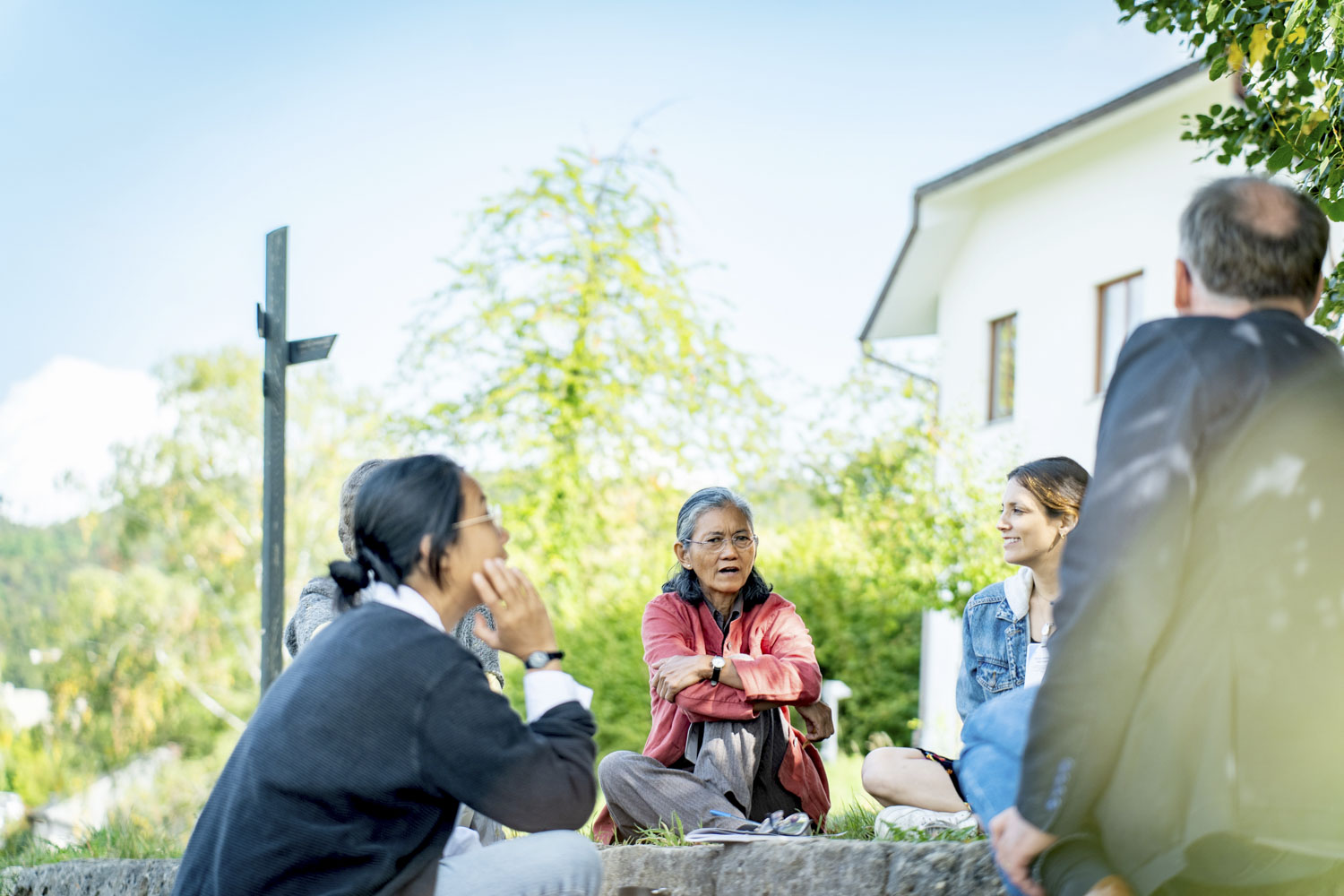
Wolfgang Müller (Germany)
What we all know in principle—that the anthroposophical movement is a world movement—suddenly became so tangible, even audible. Portuguese was spoken next to me, Dutch behind me; an Israeli read the Calendar of the Soul verse in Hebrew; I tormented a charming man from Quebec with my rusty French; over coffee, I chatted with a woman from Malaysia. True, (even if the travel costs were likely paid for in part by foundations) it is only a certain class [of people] that can meet here. Nevertheless, the fascination remains.
The weather is nice; many people are streaming by outside with their dinner trays, all the tables are full, and four of us are sitting on the steps and nearby boxes. And we suddenly find ourselves in a serious, deep conversation about the big questions of our time, both political and spiritual. In an anthroposophical environment, such conversations often come about as a matter of course: thoughtful, personal, searching, no one here lives “by bread alone.” For me, that seems to be a distinctive characteristic.
Anyone who has been to a conference is well aware that the content is often modest; it’s the encounters that count. But, my impression in the working groups is that things quickly lose focus, drift into the anecdotal, remain unconnected, one thing just following on another. Of course, one can’t expect too much strict structure from a lively exchange. But it’s not too much to hope that everyone will keep the thematic focus in mind and at least keep a distant connection. “Guarding the Theme”: I heard this nice phrase recently.
Kai Hansen (Germany)
The will and courage to be awake, to be vulnerable, and to be fragmentary, i.e., to bring an inner gesture of beginning—this experience arose during the conference like a wake-up call. The difficulties of our time were clearly present, but courage and confidence were also reflected in the personal encounters and in the initiatives from the various countries. Forums, workshops, and groups for reflection encouraged everyone to listen and brought to light how experiences of cultural diversity contribute to the spiritual picture of humanity in anthroposophy. It was a sublime wonder to experience how encounters with other cultures at this World Conference were able to reveal that we can all see each other eye-to-eye and that our different experiences are a mutual enrichment for everyone, especially when we turn towards a spirituality free of limitations. The motto “Reshaping A World Movement” had given me the impression that there was some kind of difficulty present, but the “movement” was cheerful, sincerely devoted, and engaged. It was clear that anthroposophy is perceived as something that concerns our inner world, which wants to lead to a change in the way we think and act in the outer world. More and more is being done out of voluntary recognition of one’s own commitment and activity in whatever context or direction one freely chooses. It seems to me that, as concern about the state of the world increases, the hunger for spirituality (meditation) within a framework of a realistic, sustainable, and future-oriented view of humanity is growing, too.
Transformation
At the end of the conference, around one hundred young people from all over the world stood on the stage of the Great Auditorium and unpretentiously shared their thoughts. A magnificent realisation was: “I am anthroposophy. I am Sekem. I am the one who is connected to these people.” A young man from Baden-Württemberg found that there was a nice range between the “old hands” and the “youngsters”. It was experienced on both sides and wonderfully expressed by a young Filipino farmer, that the conference is like a compost that, through our experiences and our exchange, helps our will to sprout and flourish. This echoed a formal motif of the anthroposophical movement: We will become a conference!
It was also about the movement between interior and exterior, between cognition and action. Europe is experiencing a “crisis of knowledge”, as Christiane Haid and Wolfgang Tomaschitz stated during their unprepared and, therefore, daring dialogue on stage. Something about us and our narrative of knowledge has become fragile. The question about thinking raises the question about the human being. Talking about this together with the world today requires new cognitive languages and practices.
This cannot be done theoretically. How do we describe the cognitive situation in a new way? How do we integrate a phenomenology of the interior into this? And how can we talk about this with people who are not anthroposophically oriented? One suggestion from a conversation with Wolfgang Müller was: we are only finding that language through our dealings with the non-anthroposophical world. So, it’s about openness—and clarity at the same time. For him, this means, for example, that he cannot go along with a spirituality that ignores questions of cognition.
And isn’t the label “anthroposophy” sometimes an obstacle? The non-anthroposophical world somehow vaguely assumes that the label “anthroposophy” makes a person unfree, that they are bound by the whole bundle of anthroposophical views. But we ourselves are the guarantors of spiritual freedom, so that it does not become sectarian. And there is also an obligation to make the meaning of anthroposophy understood. “If we don’t succeed, we’ll be dragged through the mud anyway,” Müller said. And there are moments when, for the sake of individual freedom, I cannot hide which “house” I belong to. After all, it is everyone’s personal responsibility as a free being to come to a judgement about the truth and reality of thoughts. I don’t have to justify my anthroposophy, but perhaps simply live it and let it live.
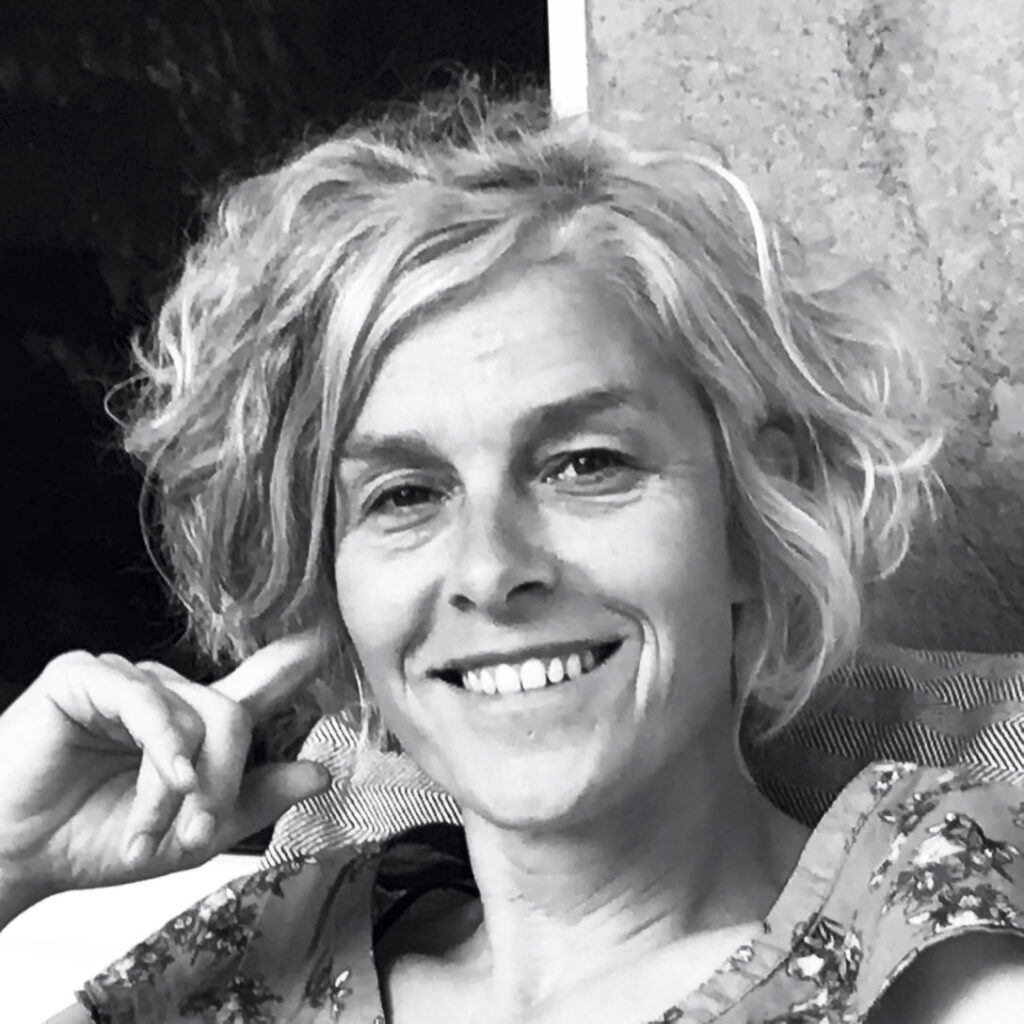
Breathing in the World
The anthroposophical world outside Dornach and Germany was wonderfully observable during these three days, in its achievements and its desire to contribute something. Some European problems show up quite differently in other parts of the world. The pioneering situation of anthroposophy that existed in Switzerland one hundred years ago is happening in other countries right now: at a different time and under different circumstances. The surroundings brought its questions and its way of working into the conference, like a mirror and as an enrichment.
There was also a wish to connect to an even greater extent. The periphery needs networking support to realise its concerns. For example, a man from Japan talked about his peace initiative to bring Germany, America, and Japan together to heal the suffering of Hiroshima and Nagasaki spiritually, in terms of “country karma”. He was looking for fellow campaigners to join him. A young Russian-Ukrainian couple reported on their attempt to understand and circumvent the warring powers. Rembert Biemond described his initiative for a “Planetary Service”. There were so many good undertakings, initiatives, encounters, anchorages, impulses, and thoughts to experience—be it through self-education, be it through preparing space for consciousness and encounters to happen, be it through creative willpower—all of which bring hope into this world, which is also at risk. It was possible for a perhaps frightened, anxious, troubled soul to feel its way trustingly into its humanity. “We are conditioned, but not fixed beings,” said Constanza Kaliks, quoting the Brazilian educationalist Paulo Freire. How we perceive ourselves and the world—how we think and feel—is up to us. Our actions arise from this.
“How challenging just to observe, and how precious just to look without speaking—an introverted day wrapped in interest,” said a woman from Iceland, describing her second day at the conference. She also asked me whether the preparatory team had deliberately designed the events to lead more into intuitive perception, so that these “senses” were consciously addressed. I don’t know exactly which beings, human or otherwise, contributed to shape the conference and in what way, but thank you!
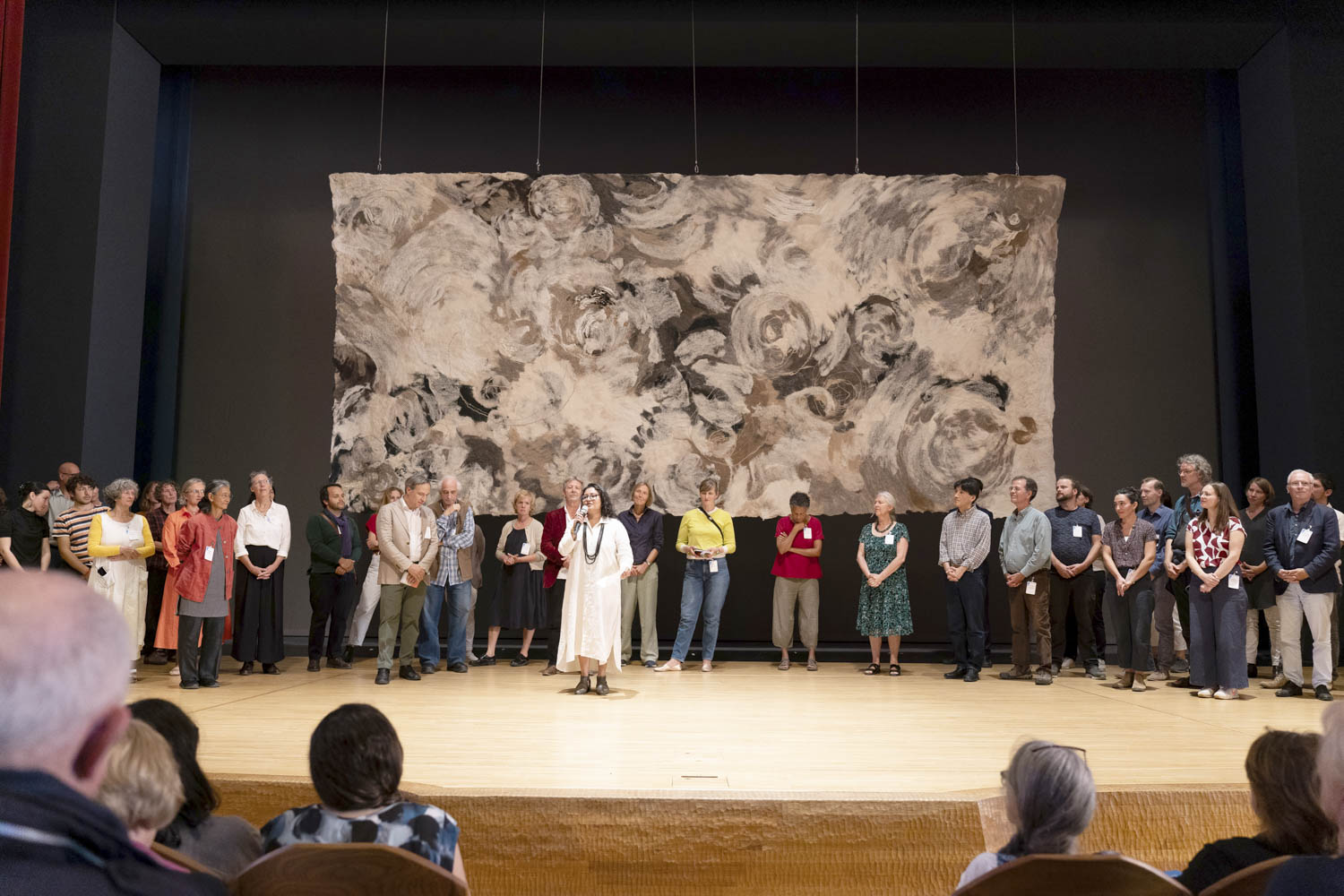
Philipp Tok (Switzerland)
Michaelmas night. Several hundred people stream out from the concert into the orchards in front of the building, gathering around a blazing fire, under a starry sky. Standing guard on the Felsli, in place of the fallen linden tree, stands a luminous sword sculpture by Rik ten Cate. The large circle of people, spreading out into the distance, resounds at various points, searching for a song to sing. The whole falls silent. Only small groups find a common tone. Everyone is on their own in this quiet, largely silent gathering, warmed by glances. When the fire has nearly extinguished itself, and the thinning circle is called closer around, a storyteller takes center stage. Pacing up and down in front of the fire, he forges his rhymes about the World’s Becoming and captivates those listening into a tale.
Benjamin Brockhaus (Germany)
The conference invitation awakened hope within my soul. I was fascinated by the idea of participating in the reorientation of the anthroposophical world movement. But the experience provided me some corrections. Old familiar questions and points of critique were formulated anew. Institutions from developing countries were the most likely to report real steps into the new. However, the impulse for collaborative development remained unclear. Perhaps the new impulse will unfold, not intellectually or through activism, but in a deepened culture of social cooperation. Tender seedlings of this cultural impulse were evident in discussions, keynote lectures, and workshops. There was a compassionate atmosphere of authentic encounter that left room for joy and pain. A strengthened courage to transparently speak the unspoken was palpable. The transformative power of a new culture of vulnerability was perceptible. Perhaps this cultural impulse has already taken place, and it is only a matter of time before it is also taken up by institutions. Am I ready to show my wound?
Translation Christian von Arnim
All images Goetheanum World Conference 2023; Photos: Xue Li

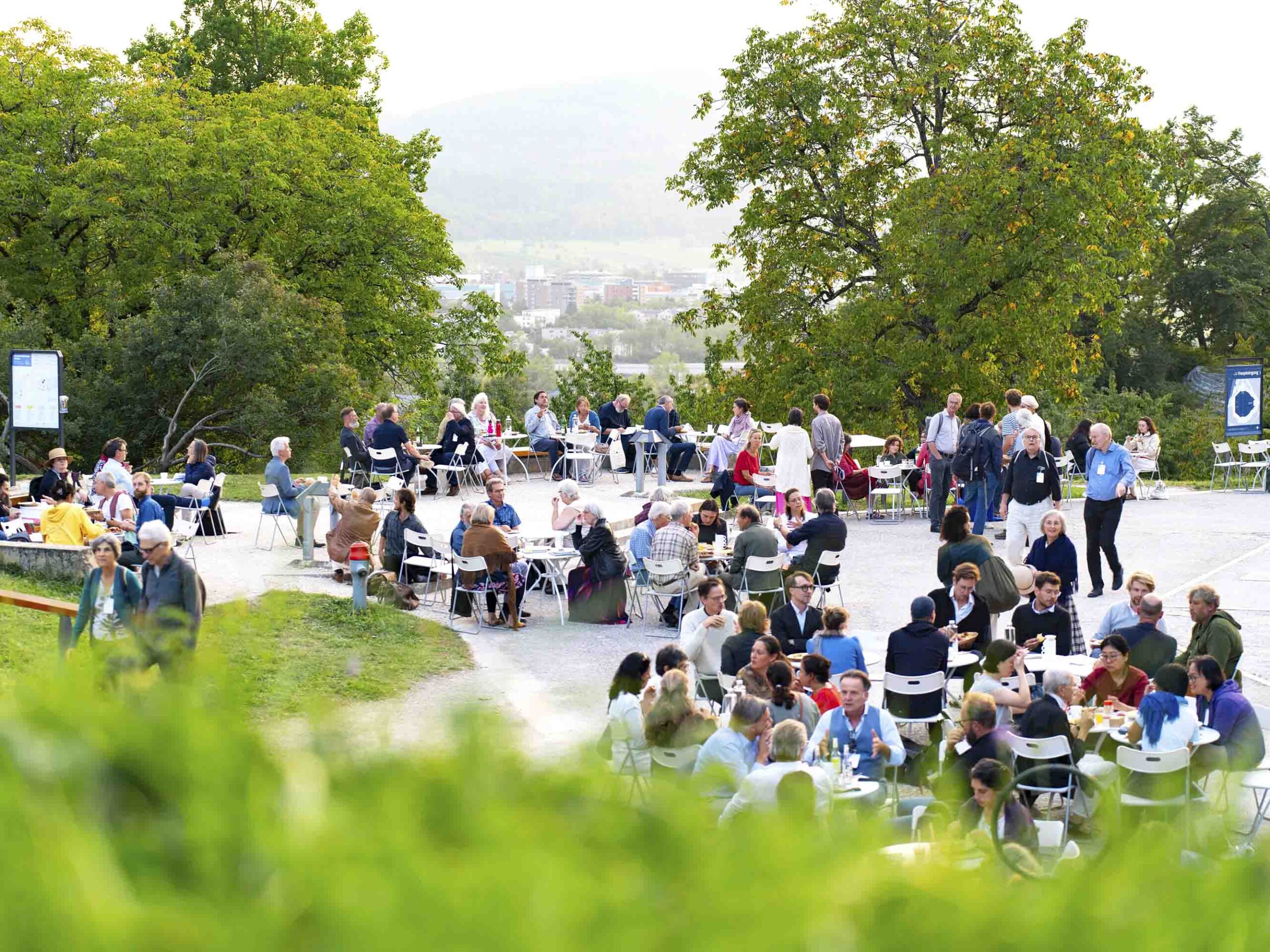

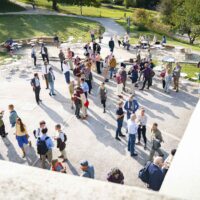
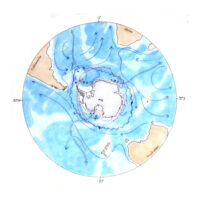

On the one hand, in reading the 12 questions, I am reminded of the time, 1962, when as an architect, I learned to ask the question before the questions. Example: Is the future of the earth necessary? Is peace something to be created by ”us”? Establish, strengthen, communicate, create, move, search, contribute, transform. Is this some kind of missionary work?
As an architect, you learn to ask, or may learn to ask, ”What happens if nothing happens here?”
On the other hand, a thorough-going, non-judgmental documentation of the past 100 years of anthroposophical activism would be worthwhile. Who did what, when, where, why and how, and with so few superlatives as possible.